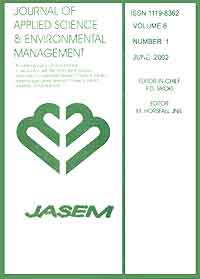
|
Journal of Applied Sciences and Environmental Management
World Bank assisted National Agricultural Research Project (NARP) - University of Port Harcourt
ISSN: 1119-8362
Vol. 20, No. 4, 2016, pp. 1105-1111
|
 Bioline Code: ja16119
Bioline Code: ja16119
Full paper language: English
Document type: Research Article
Document available free of charge
|
|
|
Journal of Applied Sciences and Environmental Management, Vol. 20, No. 4, 2016, pp. 1105-1111
| en |
Geographical Information System (GIS) Application for Planning and Improvement of Public Water Supply in Ota, Ogun State, Nigeria
UFOEGBUNE, G.C.; ATANLEY, P.A.; ERUOLA, A.O.; MAKINDE, A.A. & OJEKUNLE, Z.O.
Abstract
Geographical information system (GIS) technique is a useful tool for spatial analysis which has not been
fully exploited in solving water issues in Ota hence the study. The study applied the tool of GIS in the planning and
improvement of water supply system in Ota, Ogun state. This study harnessed the synergy of GIS and engineering designs to
proffer an acceptable solution to the problems of water supply in the study area. Primary data generated on the field with GPS
and spatial information were analysed with the aid of GIS to produce contour pattern and Digital Elevation Model (DEM) in
form of maps. The study noted that the population would increase to almost double the present population by the year 2040
invariably resulting to an increase in water demand of the population beyond the capacity of the existing water supply
facilities. Results also showed that water demand by the projected population by year 2040 will increase to 68.37 million
litres per day while the existing facility has the capacity to produce about 9.2 million litres per day. Maps produced by the
study included Contour, Digital Elevation and Existing and proposed pipeline network maps. These maps made available
more information which can then be used for improving the water supply system. The study proffered a lasting solution
through design of water scheme with capacity large enough to cater for water requirement of the population for the next
twenty-five years irrespective of variation in water need of individual residents in the area with designs to improve
distribution system through extension of pipelines and identification of various locations for service reservoirs.
Keywords
GIS; design period; per capita
|
| |
© Copyright 2016 - Journal of Applied Sciences and Environmental Management
|
|
